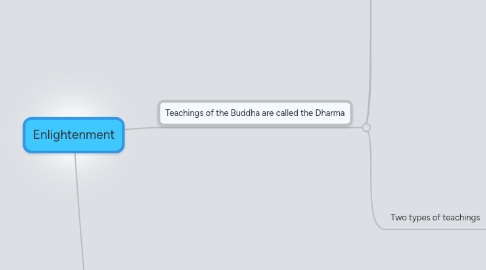
1. Teachings of the Buddha are called the Dharma
1.1. 1st official wheel of Dharma, at Sarnath Varanasi
1.1.1. The Four Noble Truths
1.1.1.1. The truth of suffering
1.1.1.2. The truth of the cause of suffering
1.1.1.3. The truth of cessation
1.1.1.4. The truth of the path that leads to the cessation of suffering
1.2. 2nd wheel of Dharma, at Vultures Peak
1.2.1. The Heart Sutra
1.2.1.1. Three Versions of Heart Sutra
1.2.1.1.1. The Elaborate version
1.2.1.1.2. The Intermediate version
1.2.1.1.3. The Simplified version
1.2.1.1.4. Classification of practice by which the lineage is passed (ways of teaching)
1.2.1.2. Three ways of understanding
1.2.1.2.1. mundane way
1.2.1.2.2. super-mundane way, beyond samara
1.2.1.2.3. unsurpassable understanding
1.2.1.3. Explanation of the text
1.2.1.3.1. Homage to Bhagavat
1.2.1.3.2. The title
1.2.1.3.3. Prolog
1.2.1.3.4. Entering the path
1.2.1.3.5. The mantra
1.2.1.4. Two types of teaching
1.2.1.4.1. Explicit
1.2.1.4.2. Inexplicit
1.3. 3rd wheel of Dharma, at Kusinagara
1.3.1. Tantra
1.4. The purpose - to be free from samsara
1.5. Two types of teachings
1.5.1. The Dharma of Transmission
1.5.1.1. The Three baskets of teachings
1.5.1.1.1. Vinaya, discipline
1.5.1.1.2. Sutra, meditation
1.5.1.1.3. Abidharma, phenomena
1.5.1.2. Shows the nature, the way and the cause of Nirvana
1.5.2. The Dharma of Realization
1.5.2.1. Paths
1.5.2.1.1. Ordinary understanding
1.5.2.1.2. Arya understanding
1.5.2.1.3. BHUMIS, Bodhisattvas paths
1.5.2.2. Inner meaning of the Mantra
1.5.2.2.1. 1. On path of accumulation
1.5.2.2.2. 2. Path of preparation
1.5.2.2.3. 3. Path of seeing
1.5.2.2.4. 4. Path of meditation
1.5.2.2.5. 5. No more learning
1.5.2.3. Describes the realisations that correspond to the levels of the path, from ordinary being to enlightenment
1.5.2.4. Three Trainings
1.5.2.4.1. Shila - Moral Ethics
1.5.2.4.2. Samadhi - Meditative Absorbtion, Concentration
1.5.2.4.3. Pranja - Wisdom
